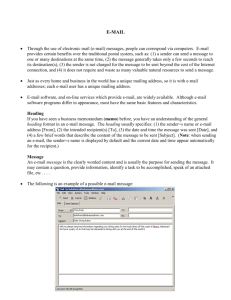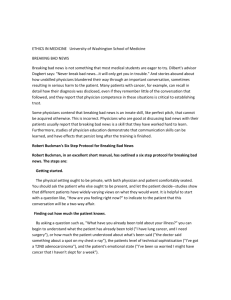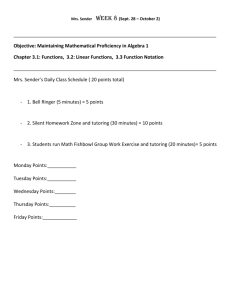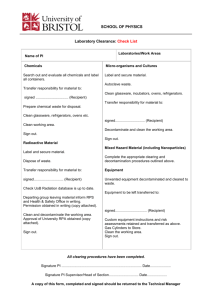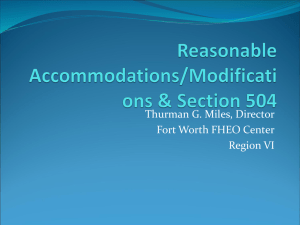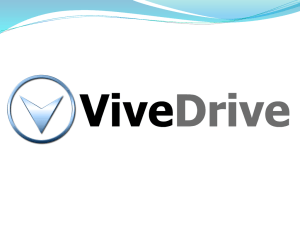here - Design Cultures & Creativity
advertisement
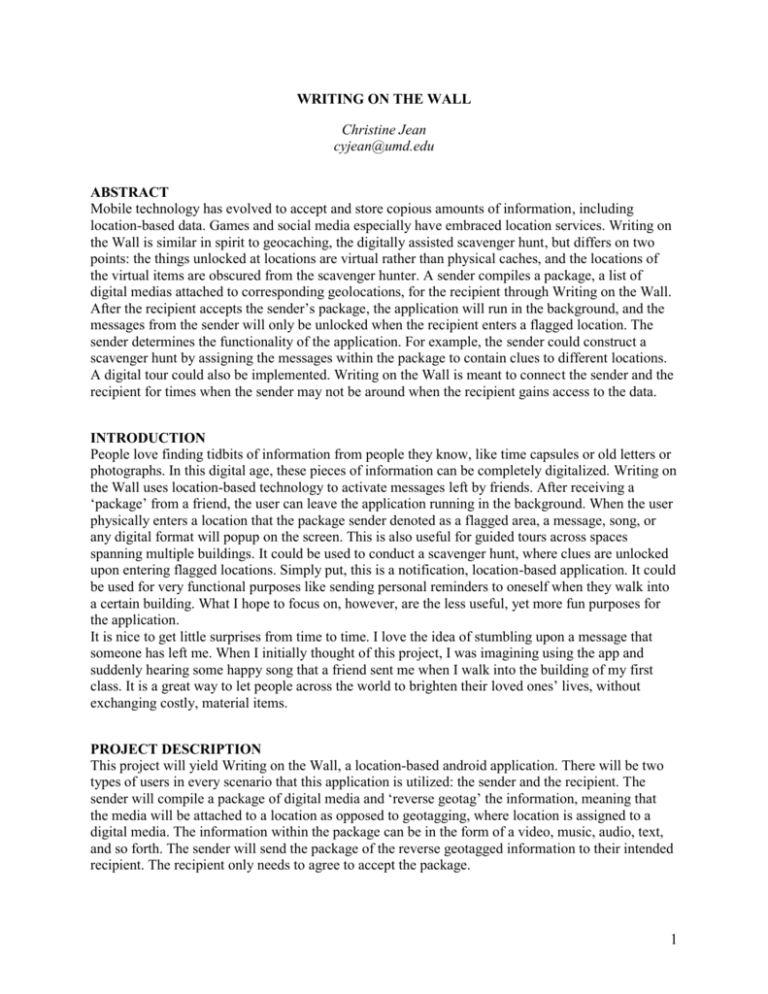
WRITING ON THE WALL Christine Jean cyjean@umd.edu ABSTRACT Mobile technology has evolved to accept and store copious amounts of information, including location-based data. Games and social media especially have embraced location services. Writing on the Wall is similar in spirit to geocaching, the digitally assisted scavenger hunt, but differs on two points: the things unlocked at locations are virtual rather than physical caches, and the locations of the virtual items are obscured from the scavenger hunter. A sender compiles a package, a list of digital medias attached to corresponding geolocations, for the recipient through Writing on the Wall. After the recipient accepts the sender’s package, the application will run in the background, and the messages from the sender will only be unlocked when the recipient enters a flagged location. The sender determines the functionality of the application. For example, the sender could construct a scavenger hunt by assigning the messages within the package to contain clues to different locations. A digital tour could also be implemented. Writing on the Wall is meant to connect the sender and the recipient for times when the sender may not be around when the recipient gains access to the data. INTRODUCTION People love finding tidbits of information from people they know, like time capsules or old letters or photographs. In this digital age, these pieces of information can be completely digitalized. Writing on the Wall uses location-based technology to activate messages left by friends. After receiving a ‘package’ from a friend, the user can leave the application running in the background. When the user physically enters a location that the package sender denoted as a flagged area, a message, song, or any digital format will popup on the screen. This is also useful for guided tours across spaces spanning multiple buildings. It could be used to conduct a scavenger hunt, where clues are unlocked upon entering flagged locations. Simply put, this is a notification, location-based application. It could be used for very functional purposes like sending personal reminders to oneself when they walk into a certain building. What I hope to focus on, however, are the less useful, yet more fun purposes for the application. It is nice to get little surprises from time to time. I love the idea of stumbling upon a message that someone has left me. When I initially thought of this project, I was imagining using the app and suddenly hearing some happy song that a friend sent me when I walk into the building of my first class. It is a great way to let people across the world to brighten their loved ones’ lives, without exchanging costly, material items. PROJECT DESCRIPTION This project will yield Writing on the Wall, a location-based android application. There will be two types of users in every scenario that this application is utilized: the sender and the recipient. The sender will compile a package of digital media and ‘reverse geotag’ the information, meaning that the media will be attached to a location as opposed to geotagging, where location is assigned to a digital media. The information within the package can be in the form of a video, music, audio, text, and so forth. The sender will send the package of the reverse geotagged information to their intended recipient. The recipient only needs to agree to accept the package. 1 After accepting the package, the recipient’s actions are very passive; the recipient will not need to do much. They will carry on with their normal lives. The application will use the radio frequency signal tracker to get the estimate location-based upon the connected cell tower (Hunt 2009). When the recipient is close to any flags, the application will then switch over to using AGPS. This will be done to conserve battery life. Upon arriving at a flagged location, the corresponding digital media within the package will be revealed to the recipient. All of this will be developed with the Android Developer Kit. The client/server network to keep track of users and allow packages to be sent between specific people will be hosted on a server. I will be focusing on the hidden scavenger hunt idea, so features may include a map interface for the sender to use to add information to corresponding locations. HISTORY Location-based services started in 1989 with the Active Badge System, used mainly by universities and research laboratories, where others could access the location of the individuals who carried the small Active Badge device (Active Badge System 2002). In 1996, Enhanced911 was mandated in the US so emergency services could physically locate wireless callers (FCC 1996). The Palm VII with location-based services was released in 2000, becoming the first mobile device for mass consumption (Buczkowski 2012). In 2004, Qualcomm was able to apply assisted GPS to the mobile phone. As Wifi and GPS became more widespread and feasible, location-based technology became more accessible. After location-based services became clearly implementable and more well known, people began exploring other creative ideas. The geocaching movement started in 2000, the day after GPS became available for everyone to use (O’Hara 2008). In the Tangible Flags project, kids looked and took notes at radio-frequency identification tagged locations in a national park (Chipman 2006), while in Tag and Seek, the interest points where identified with near field communication tags (Arkenson 2014). These flags needed to be places beforehand however, and could be intrusive when placed in some spaces. Geocaching also requires leaving something physical in a physical location. Writing on the Wall lets the sender leave digital messages instead. The M-Views project created an interactive video experience based upon participants’ locations in 2006 and noted that small screens were intrusive for connecting to the space (Crow). Furthermore, the recipient unlocking unexpected messages can be ‘novel, unexpected events,’ which may elicit intense emotions (Wilson 2005). The lack of knowledge that the recipient has of what the package contains in the project serves two purposes: to be as nonintrusive as possible on the experience in the physical space, and to make a recipient happy by surprising them. SIGNIFICANCE AND DISTINCTION Writing on the Wall is a mobile application where its function is determined by the sender and the sender’s intent for the recipient. This project, when used as a scavenger hunt, is similar to geocaching, but the recipient may not know where the cache is hidden, and the cache is digital instead of physical. The way the sender compiles flags is ‘reverse geotagging,’ where instead of recording digital information and remembering a location, the process becomes using a location to then assign a digital media. These features make this mobile application highly versatile in use. It can be used by a single person who acts as the sender and recipient of data for a grocery list, where the things the person needs to buy pops up on their phone upon entering a store. Or it could be programmed for a physical tour guide with digital aids. Or it could be used to surprise recipients when they walk into certain locations. There is a customizable part within this project that I have not seen in other location-based mobile applications. 2 Location-based technology has become mainstream, especially with mobile applications. Many social medias, like Facebook, Twitter, and Instagram, geotag media that people post. Other social media based more upon location, like Foursquare, connect large amounts of people with the added twist of getting rewards from local retailers. There are also location-based games like the augmented reality game Pokemon GO scheduled to come out in 2016. These general categories are most similar to what Writing on the Wall is about. However, none of these existing mobile applications are meant to be used by one person to communicate to a few people; social media and big games are great for connecting many people, but I wanted something that was more intimate and personal. EXPERTISE AND SKILLS I know and will be using Java to code this project. Having taken the upper level DCC courses that relate to design and prototyping, I am familiar with the concepts concerning good technologically based design. I am a proficient smartphone user, though I need to familiarize myself with using android devices. I will be taking a handheld mobile device programming class for android devices next semester that will help me throughout this project, but I would also need to learn how to do many things on my own time to fulfill the goals detailed in the timeline. APPROACH I will be doing informal research for prototyping by asking potential users for feedback. I will first focus on getting feedback on the functionality of the application and possible features the application could include before beginning the backend coding. After creating the backend and a rough user interface, I will create the design prototype and repeat the process of getting user feedback. Then I will focus on the design of the interface. BENCHMARKS Intended final goal: In early May, I will have a working mobile application with a good usable interface on the Google Play Store. Intermediate goal: By mid April, I will have a functioning mobile application which includes all the intended features. Early intermediate goal: By mid March, I will have an application that sends notifications to the recipient when they enter a flagged location. WORK PLAN AND TIMELINE Preparation for this project December 1st to January 31th Finishing most of the backend Focusing on frontend February 1st to 7th February 8th to 14th February 15th to 28th March 1st to 19th Learn how to use the Android Developer Kit and decide on general features necessary for this app Have GPS and triangulation working Set up the client/server network Create a rough UI Focus on the UI for when the sender wants to send out a 3 package March 20 to 31 Test out the design as a sender and recipient within the application st th Finalizing and submitting April 1 to 15 Finalize the application and post it onto the Google Play Store Because I will be developing this mobile application for android only, I will not need to worry about cross-platform challenges. I will be using the Android Development Kit. I have access to an android device emulator through ADK, as well as physical device that I can test this project with. I will be publishing this mobile application to the Google Play Store. th st AUDIENCE Writing on the Wall is intended for people who may not have the means to see people they care about often. This application would be useful for college students to communicate with family and friends. People coming to a new place could benefit from the tour guide scenario this application could be utilized for. Parents, such as incarcerated persons or soldiers overseas, who want to put in the time to create something special for the people they have no physical access to and have limited resources beyond that of a smartphone, may appreciate this application. BUDGET Estimated budget: $0 to $10 if I buy other android apps to analyze and possibly emulate. I do not need money for an android device or a server, as I currently have access to both. OUTCOMES I want to learn how to program in android; it is a valuable and often underrated skill as a computer scientist. In HDCC106 and HDCC208N, I learned about prototyping, user interfaces, and design; developing a mobile application would allow me to put those skills to use. Being in DCC has exposed me to so many projects that are not necessarily quantitatively impactful, but are definitely qualitatively impactful. I want to make people happier and closer, especially now that social media seems to be paradoxically making people less connected. I aim to distribute Writing on the Wall on Google Play, but if I am not satisfied with what I accomplish, I will make it available on my website. Given the wide range of situations it could be used for, there will probably be plenty of features that I may want to implement but realistically will not accomplish during the span of the capstone project. BIBLIOGRAPHY The Active Badge System. (2002). Retrieved November 23, 2015, from http://www.cl.cam.ac.uk/research/dtg/attarchive/ab.html Arkenson, C., Chou, Y. Y., Huang, C. Y., & Lee, Y. C. (2014, October). Tag and seek: a locationbased game in Tainan City. In Proceedings of the first ACM SIGCHI annual symposium on Computer-human interaction in play (pp. 315-318). ACM. 4 Buczkowski, A. (2012). Location-Based Services - Chronology - Geoawesomeness. Retrieved November 23, 2015, from http://geoawesomeness.com/knowledge-base/location-basedservices/location-based-services-chronology/ Chipman, G., Druin, A., Beer, D., Fails, J. A., Guha, M. L., & Simms, S. (2006, June). A case study of tangible flags: a collaborative technology to enhance field trips. In Proceedings of the 2006 conference on Interaction design and children (pp. 1-8). ACM. Crow, D., Pan, P., Kam, L., & Davenport, G. (2003, October). M-Views: A System for LocationBased Storytelling. In ACM UbiComp. Enhanced911. (1996). Retrieved November 23, 2015, from https://transition.fcc.gov/Bureaus/Wireless/Orders/1996/fcc96264.txt Hunt, K. (2009, October 1). RF Signal Tracker - androiddevelopmentproject. Retrieved November 23, 2015, from https://sites.google.com/site/androiddevelopmentproject/home/rf-signal-tracker O'Hara, K. (2008, April). Understanding geocaching practices and motivations. In Proceedings of the SIGCHI Conference on Human Factors in Computing Systems (pp. 1177-1186). ACM. Qualcomm Announces Completion of Assisted-GPS Test Calls for WCDMA (UMTS)/GSM/GPRS Networks | Qualcomm. (2004, November 10). Retrieved November 23, 2015, from https://www.qualcomm.com/news/releases/2004/11/10/qualcomm-announces-completion-assistedgps-test-calls-wcdma-umtsgsmgprs Wilson, T. D., Centerbar, D. B., Kermer, D. A., & Gilbert, D. T. (2005). The pleasures of uncertainty: prolonging positive moods in ways people do not anticipate. Journal of personality and social psychology, 88(1), 5. 5
